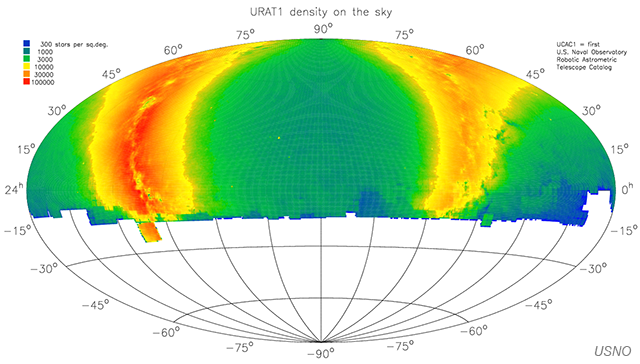USNO Releases First Version of Newest Star Catalog
Norbert Zacharias Retired
This announcement is adapted from a US Naval Observatory press release (PDF):
The United States Naval Observatory (USNO) has released the first edition of its USNO Robotic Astrometric Telescope star catalog, URAT1. This catalog is the follow-on to the USNO CCD Astrograph Catalog (UCAC4). The new catalog contains positional data on about 228 million stars with a magnitude range of 3.0 to 18.5 for a bandpass of 680 to 750 nanometers between declinations of +89.5° and −15°. Longer integration times and more sensitive, backside-illuminated CCDs allowed for a substantial increase in limiting magnitude, resulting in a nearly four-fold increase in the average number of stars per square degree as compared to UCAC.
URAT1 is supplemented by preliminary proper motions derived exclusively from two-epoch URAT1 and Two Micron All Sky Survey (2MASS) data (at around epoch 2000) resulting in proper motion errors of typically 5 to 8 milliarcseconds (mas)/year. Photometry from 2MASS and the American Association of Variable Star Observers Photometric All-Sky Survey (APASS) is added for stars in common with URAT1.
The catalog was created using the same "red lens" used in the preceding UCAC catalogs; however, the lens was installed in a completely redesigned tube assembly fitted with a new, state-of-the-art large-format charge-coupled device (CCD) camera. This new camera consists of an array of four of the world's largest monolithic CCD detectors, each of which has 10,560 x 10,560 x 9-micron pixels. This array is cooled by liquid nitrogen and forms a large-scale focal plane that covers about 28 square degrees of the sky in a single image. The telescope, currently installed at the US Naval Observatory Flagstaff Station (NOFS), has been designed to run autonomously with minimal human intervention.In April 2012 URAT began to systematically image the sky every clear night for a period of just over two years. Over 65,000 individual images were exposed during this time. Each individual exposure contains about 1 gigabyte of data. The positions of the stars in the URAT1 catalog are known to within 5 to 30 milliarcseconds.
URAT1 will be available to users through the astrometric catalog server at the Strasbourg Astronomical Data Center (CDS) as Catalog I/329.
Current plans call for a second URAT2 data release in about a year, which will include 3+ years of operations, proper motions, and parallaxes (of nearby stars) derived from URAT data.
Founded in 1830, the U.S. Naval Observatory functions as an operational Navy unit under the Commander, Naval Meteorology and Oceanography Command and United States Fleet Forces Command, maintaining and disseminating the Department of Defense's official timescale used by GPS and other Defense satellite systems, as well as collecting astrometric information required to operate a wide variety of strategic systems.



